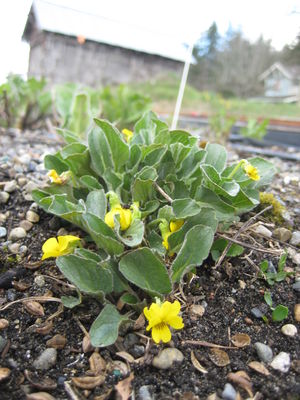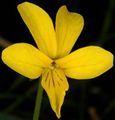Difference between revisions of "Viola nuttallii var. praemorsa"
(→Taxonomy) (Tag: VisualEditor) |
|||
| (4 intermediate revisions by the same user not shown) | |||
| Line 1: | Line 1: | ||
| − | |||
* Scientific Name: ''Viola nuttallii'' var. ''praemosa'' | * Scientific Name: ''Viola nuttallii'' var. ''praemosa'' | ||
* Family: Violaceae | * Family: Violaceae | ||
| Line 5: | Line 4: | ||
* Synonyms/Misapplications: V. ''praemorsa'', V, ''praemosa'' vars. ''flavovirens, linguifolia'' | * Synonyms/Misapplications: V. ''praemorsa'', V, ''praemosa'' vars. ''flavovirens, linguifolia'' | ||
* Codon: VIONUT | * Codon: VIONUT | ||
| + | ---- | ||
| + | [[File:VIPR AnitaGoodrich veg good.jpg|thumb|Photo Anita Goodrich, also featured on Main Page]] | ||
| − | ==Taxonomy== | + | ===Taxonomy=== |
{{Taxobox | {{Taxobox | ||
| − | | name = | + | | name = |
| regnum = [[Plant]]ae | | regnum = [[Plant]]ae | ||
| subregnum = Viridiplantae | | subregnum = Viridiplantae | ||
| Line 26: | Line 27: | ||
<ref>Integrated Taxonomic Information System. Retrieved from https://www.itis.gov/servlet/SingleRpt/SingleRpt?search_topic=TSN&search_value=847695#null</ref> | <ref>Integrated Taxonomic Information System. Retrieved from https://www.itis.gov/servlet/SingleRpt/SingleRpt?search_topic=TSN&search_value=847695#null</ref> | ||
| − | ==Description== | + | ===Description=== |
| − | + | Perennial, rhizomatous herb with axillary yellow flowers, to 30 cm tall.<ref name=":1">Jepson Herbarium Online Flora. Retrieved from https://ucjeps.berkeley.edu/eflora/eflora_display.php?tid=53398</ref> Stems several, erect, borne from underground caudices,<ref name=":1" /> hairy.<ref name=":2">E-Flora | |
| − | Leaves: | + | BC: Electronic Atlas of the Flora of British Columbia. Retrieved from https://linnet.geog.ubc.ca/Atlas/Atlas.aspx?sciname=Viola%20praemorsa&redblue=Both&lifeform=7</ref> Leaves mostly basal,<ref name=":2" /> not coarsely veined, crenate to serrate,<ref name=":3" /> hairy, fleshy, petiolate, ovate-lanceolate, to 10 cm, petioles to 15 cm long.<ref name=":0">WTU Herbarium, Burke Museum, & University of Washington. |
| + | Retrieved from https://biology.burke.washington.edu/herbarium/imagecollection/taxon.php?Taxon=Viola%20nuttallii%20var.%20praemorsa</ref> Flowers 5-merous, solitary, axillary, zygomorphic; sepals 5, lanceolate;<ref name=":1" /> petals 5, lowermost larger and spurred, upper 4 in 2 pairs;<ref name=":3" /> lower 3 petals with brown-purple veins, lateral 2 bearded;<ref name=":1" /> stamens 5, connivent around pistil;<ref name=":3" /> pistil 3-carpellate with 1 style,<ref name=":3" /> bearded stigma<ref name=":0" /> and superior ovary with parietal placentation becoming a ellipsoid to oblong<ref name=":3" /> 3-valved capsule.<ref name=":0" /> | ||
| − | + | ===Bloom Period=== | |
| − | + | April-July<ref name=":0" /> | |
| − | + | ===Distribution=== | |
| − | + | Both sides of the Cascades, into Northern California, east to Montana, Wyoming and Northern Utah.<ref name=":3">Hitchcock, C. L., Cronquist, A., Giblin, D., & Legler, | |
| − | + | ||
| − | == | + | |
| − | + | ||
| − | + | ||
| − | Both sides of the Cascades, into Northern California, east to Montana, Wyoming and Northern Utah.<ref>Hitchcock, C. L., Cronquist, A., Giblin, D., & Legler, | + | |
B. et al. (2018). ''Flora of the Pacific Northwest: an illustrated manual''. | B. et al. (2018). ''Flora of the Pacific Northwest: an illustrated manual''. | ||
Seattle: University of Washington Press.</ref> | Seattle: University of Washington Press.</ref> | ||
| − | ==Habitat== | + | ===Habitat=== |
| − | Grasslands, shrub-steppe, open forest. | + | Grasslands, shrub-steppe, open forest.<ref name=":0" /> |
| − | + | ||
| − | + | === Propagation === | |
| + | [https://rngr.net/npn/propagation/protocols/violaceae-viola-4085/?searchterm=Viola%20praemorsa Native Plant Network Propagation Protocol] | ||
| − | ==Photo Gallery | + | ===Photo Gallery=== |
<gallery> | <gallery> | ||
File: Viola nuttallii facing 1.jpg | G.D. Carr 2008 | File: Viola nuttallii facing 1.jpg | G.D. Carr 2008 | ||
| Line 54: | Line 52: | ||
</gallery> | </gallery> | ||
| − | ==References== | + | ===References=== |
<references /> | <references /> | ||
Latest revision as of 16:36, 30 June 2021
- Scientific Name: Viola nuttallii var. praemosa
- Family: Violaceae
- Common Names: canary violet, upland yellow violet, yellow montane violet
- Synonyms/Misapplications: V. praemorsa, V, praemosa vars. flavovirens, linguifolia
- Codon: VIONUT
Contents
Taxonomy
| Scientific classification | |
|---|---|
| Kingdom: | Plantae |
| Subkingdom: | Viridiplantae |
| Phylum: | Tracheophyta |
| Subphylum: | Spermatophytina |
| Class: | Magnoliopsida |
| Subclass: | Rosanae |
| Order: | Malpighiales |
| Family: | Violaceae |
| Genus: | Viola L. |
| Species: | Viola nuttallii Pursh |
| Subspecies: | Viola nuttalli var. praemorsa (Douglas ex Lindl.) S. Watson (not accepted) |
| Synonyms | |
| |
Description
Perennial, rhizomatous herb with axillary yellow flowers, to 30 cm tall.[2] Stems several, erect, borne from underground caudices,[2] hairy.[3] Leaves mostly basal,[3] not coarsely veined, crenate to serrate,[4] hairy, fleshy, petiolate, ovate-lanceolate, to 10 cm, petioles to 15 cm long.[5] Flowers 5-merous, solitary, axillary, zygomorphic; sepals 5, lanceolate;[2] petals 5, lowermost larger and spurred, upper 4 in 2 pairs;[4] lower 3 petals with brown-purple veins, lateral 2 bearded;[2] stamens 5, connivent around pistil;[4] pistil 3-carpellate with 1 style,[4] bearded stigma[5] and superior ovary with parietal placentation becoming a ellipsoid to oblong[4] 3-valved capsule.[5]
Bloom Period
April-July[5]
Distribution
Both sides of the Cascades, into Northern California, east to Montana, Wyoming and Northern Utah.[4]
Habitat
Grasslands, shrub-steppe, open forest.[5]
Propagation
Native Plant Network Propagation Protocol
Photo Gallery
References
- ↑ Integrated Taxonomic Information System. Retrieved from https://www.itis.gov/servlet/SingleRpt/SingleRpt?search_topic=TSN&search_value=847695#null
- ↑ 2.0 2.1 2.2 2.3 Jepson Herbarium Online Flora. Retrieved from https://ucjeps.berkeley.edu/eflora/eflora_display.php?tid=53398
- ↑ 3.0 3.1 E-Flora BC: Electronic Atlas of the Flora of British Columbia. Retrieved from https://linnet.geog.ubc.ca/Atlas/Atlas.aspx?sciname=Viola%20praemorsa&redblue=Both&lifeform=7
- ↑ 4.0 4.1 4.2 4.3 4.4 4.5 Hitchcock, C. L., Cronquist, A., Giblin, D., & Legler, B. et al. (2018). Flora of the Pacific Northwest: an illustrated manual. Seattle: University of Washington Press.
- ↑ 5.0 5.1 5.2 5.3 5.4 WTU Herbarium, Burke Museum, & University of Washington. Retrieved from https://biology.burke.washington.edu/herbarium/imagecollection/taxon.php?Taxon=Viola%20nuttallii%20var.%20praemorsa





